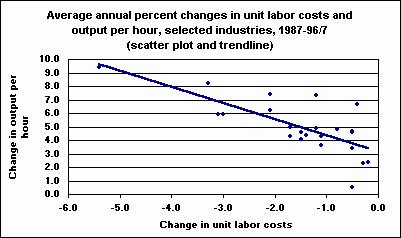An official website of the United States government
 United States Department of Labor
United States Department of Labor
Since 1987, unit labor costs have risen for 86 percent of the 173 industries included in a recent BLS report. However, there are about two dozen industries in which unit labor costs actually fell over the same period.

[Chart data—TXT]
The data show a strong inverse relationship between changes in labor productivity—measured by output per hour—and changes in unit labor costs. In fact, all 23 industries that experienced declining unit labor costs since 1987 also experienced rising productivity.
The chart displays the rate of change in unit labor costs and the rise in output per hour in the 23 industries with declining unit labor costs. Follow the "Chart data—TXT" link for a list of those industries.
These data are a product of the BLS Industry Productivity program. Data are subject to revision. Unit labor costs—the cost of the labor input required to produce one unit of output—are computed by dividing total compensation by real output. For more information see BLS Report 939, "Unit Labor Costs for Selected Industries, 1987-97," (PDF 44K).
Bureau of Labor Statistics, U.S. Department of Labor, The Economics Daily, Declines in unit labor costs and gains in productivity at https://www.bls.gov/opub/ted/1999/dec/wk4/art04.htm (visited April 25, 2024).

